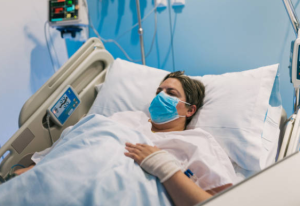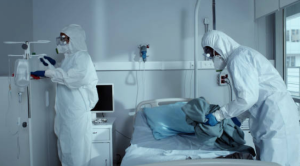Hospital beds are vital for infection control in healthcare settings. They’re designed with features and materials that are easy to clean and disinfect, reducing infection risks. Materials like antimicrobial fabrics and waterproof covers prevent bacteria and viruses growth. Design features like removable side rails and mattress covers also aid thorough cleaning. This article explores these aspects and innovative technologies in free hospital beds for infection control, emphasizing their role in ensuring a safe and sterile environment for patients. Discover how hospital beds help maintain a clean and germ-free setting.
Types Of Materials Used In Hospital Bed Mattresses
In this discussion, we’ll explore the different types of mattress materials used in hospital beds and the pros and cons of each material. You’ll learn about the various options available, such as foam, innerspring, and air mattresses, and how they can impact infection control in healthcare settings.

By understanding the advantages and disadvantages of each material, you can make an informed decision when choosing the right mattress for your hospital bed.
Discussion Of Different Types Of Mattress Material
Choose a mattress material that suits your needs and preferences – it’s essential to consider the different options available.
One common type of mattress material used in hospitals is foam. Foam mattresses are known for their comfort and pressure-relieving properties, making them suitable for patients at risk of developing pressure ulcers. They also provide excellent support and can contour to the body’s shape, ensuring proper alignment and reducing the risk of musculoskeletal issues. Foam mattresses retain heat and are less durable than other materials, so choosing a high-quality foam mattress that meets your specific requirements is essential.
Another popular choice for hospital bed mattresses is air-filled mattresses. These mattresses use air cells that can be adjusted to provide the desired level of firmness or softness. The ability to customize the mattress’s firmness makes it suitable for patients with varying needs and preferences. Air-filled mattresses distribute pressure evenly, reducing the risk of pressure ulcers and promoting better blood circulation. Air-filled mattresses can be noisy due to the air pump, and they require regular maintenance and monitoring to ensure optimal performance.
It’s crucial to weigh the pros and cons of each mattress material and consult with healthcare professionals to determine the best option for your specific situation.
Pros And Cons Of Each Material
Consider the following pros and cons when deciding on a mattress material that suits your needs and preferences.
One popular material used in hospital beds is foam. Foam mattresses offer excellent pressure relief, contouring to your body shape and reducing the risk of pressure sores. They also provide good motion isolation, ensuring minimal disturbance from your partner’s movements. Foam mattresses can retain heat, making them uncomfortable for those who tend to sleep hot. Foam deteriorates over time, leading to sagging and reduced support.
Another option to consider is an innerspring mattress. These mattresses are known for their durability and support. They have a robust, supportive structure that can withstand heavy use without losing shape. Innerspring mattresses also have good breathability, allowing for better airflow and temperature regulation. They do not offer as much pressure relief as foam mattresses, which can be a concern for individuals with certain medical conditions or injuries.
When choosing a mattress material for your hospital bed, weighing the pros and cons of each option is essential. Consider factors such as pressure relief, motion isolation, heat retention, durability, and support.
By carefully considering your needs and preferences, you can find a mattress material that promotes both comfort and infection control in the healthcare setting.
Design Features Of Hospital Beds That Facilitate Easy Cleaning
In this discussion, we’ll explore the key points related to the design features of hospital beds that make cleaning easier. You’ll learn about the different bed designs and how they can facilitate cleaning.

We’ll also discuss the pros and cons of each design, helping you understand which features are most beneficial in maintaining a clean and hygienic environment.
Discussion Of Bed Design Features That Make Cleaning Easier
Make sure you’re using hospital beds with design features that make cleaning more accessible so you can effectively combat infections and ensure the safety of patients and staff.
One important design feature to look for is a bed with smooth surfaces and minimal crevices. This makes it easier to wipe down and disinfect the bed, as there are fewer places for bacteria and other pathogens to hide.
Beds with removable parts, such as detachable headboards and footboards, are also beneficial as they allow for more thorough cleaning. Beds with a low profile or an open framework make it easier to access hard-to-reach areas and clean underneath the bed.
Another feature to consider is the material of the bed. Beds made of non-porous materials, such as stainless steel or high-density polyethylene, are easier to disinfect than beds with fabric or upholstered surfaces. Non-porous materials are less likely to absorb fluids and can be wiped clean more effectively.
Beds with antimicrobial coatings are also worth considering, as they can help inhibit the growth of bacteria and reduce the risk of infections. By choosing hospital beds with these design features, you can streamline the cleaning process, reduce the risk of contamination, and create a safer environment for patients and healthcare workers.
Pros And Cons Of Different Bed Designs
To optimize patient care and safety, weighing the advantages and disadvantages of various bed designs is crucial.
One typical bed design is the standard manual bed, which is simple and cost-effective. Its manual controls allow for easily adjusting the bed’s height and headrest. These beds can be challenging to clean due to their numerous mechanical parts and crevices that can harbor bacteria. Manual beds require physical exertion to adjust, which is challenging for healthcare providers and leading to work-related injuries.
Electric beds offer more advanced features and easier maneuverability. These beds can be adjusted electronically, reducing the strain on healthcare providers and allowing for precise positioning of patients. Electric beds have removable components, making them easier to clean and disinfect. They tend to be more expensive than manual beds and rely on electricity, which can be a potential safety hazard if not properly maintained.
Ultimately, the choice of bed design is to each healthcare facility’s specific needs and resources. It is essential to consider factors such as infection control, ease of cleaning, cost, and staff ergonomics when selecting the most suitable bed design for a hospital setting. By carefully evaluating the pros and cons of different bed designs, healthcare providers can ensure that patient care is optimized while maintaining a safe and hygienic environment.
Discover More : Alternative Bed Solutions during Health Crises
Technologies Used In Hospital Beds For Infection Control
In this discussion, you’ll explore using antibacterial coatings and other technologies in hospital beds for infection control. You’ll learn about the benefits and drawbacks of these different technologies, allowing you to make informed decisions about which options are most effective in your healthcare facility.

By understanding the pros and cons, you can ensure that your hospital beds are equipped with the best technologies to prevent the spread of infections and promote patient safety.
Access Articles: How To Use A Hospital Bed?
Discussion Of Antibacterial Coatings And Other Technologies
Antibacterial coatings and other advanced technologies are revolutionizing how hospital beds are designed and used, ensuring a safer and more hygienic environment for patients and healthcare workers. One of the most commonly used technologies is the incorporation of antimicrobial coatings on the surfaces of hospital beds. These coatings are designed to kill or inhibit the growth of bacteria, viruses, and other pathogens, reducing the risk of healthcare-associated infections. They work by releasing antimicrobial agents that can penetrate the cell walls of microorganisms, disrupting their normal function and ultimately leading to their destruction.
This helps prevent the spread of infections and extends the bed’s lifespan, as the antimicrobial properties can inhibit the growth of mold, mildew, and other damaging organisms.
In addition to antibacterial coatings, hospital beds are equipped with other advanced technologies to enhance infection control. For example, many beds now come with built-in sensors that can detect and alert healthcare staff to the presence of moisture on the bed surface, such as urine or blood. This allows for prompt cleaning and disinfection, reducing the risk of cross-contamination.
Furthermore, some beds are equipped with UV-C light systems that can be used to disinfect the bed surface between patients. UV-C light is known for its ability to kill bacteria and viruses by damaging their DNA, making it an effective tool in infection control.
By integrating these advanced technologies into hospital beds, healthcare facilities can significantly reduce the risk of infections and create a safer environment for patients and healthcare workers.
Pros And Cons Of Different Technologies
One of the advantages of incorporating advanced technologies in hospital bed design is the ability to detect and address potential hygiene issues quickly. Using antibacterial coatings, for example, hospital beds can actively kill or inhibit the growth of bacteria, reducing the risk of infections. This technology provides a continuous layer of protection, preventing the accumulation and spread of harmful pathogens.
Some antibacterial coatings are also self-regenerating, meaning they can replenish themselves over time, ensuring long-lasting effectiveness.
Another technology that can enhance infection control in hospital beds is using sensors. These sensors can monitor and track various parameters such as temperature, humidity, and pressure. By constantly monitoring these factors, healthcare providers can identify potential areas of concern and take immediate action.
For instance, if a sensor detects an increase in humidity levels, it could indicate the presence of moisture, which is conducive to bacterial growth. Prompt intervention can be taken to address the issue, preventing the spread of infections.
Incorporating these advanced technologies in hospital bed design can significantly improve infection control measures, ensuring a safer and healthier patient environment.
Conclusion
In conclusion, hospital beds are pivotal for infection control through material choice, design features, and advanced technologies. Materials like antimicrobial fabrics hinder microorganism growth. Design elements like removable covers and smooth surfaces simplify cleaning. Advanced technologies like UV-C light and antimicrobial coatings reduce cross-contamination risks. These measures and regular cleaning create a safe, hygienic patient environment. Hospital beds are essential for patient care and in curbing infections, improving outcomes, and lowering healthcare-associated infection rates.
